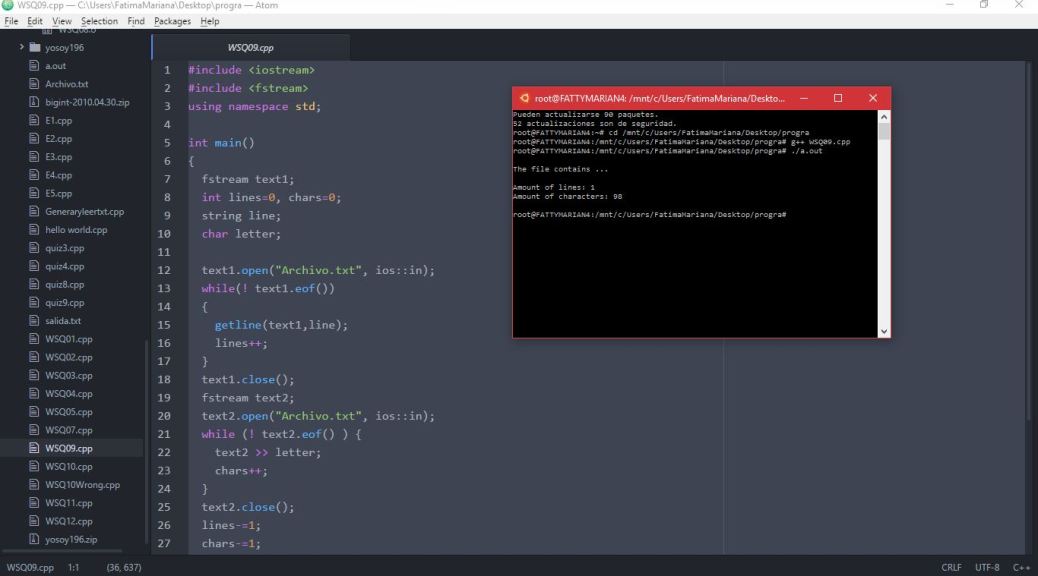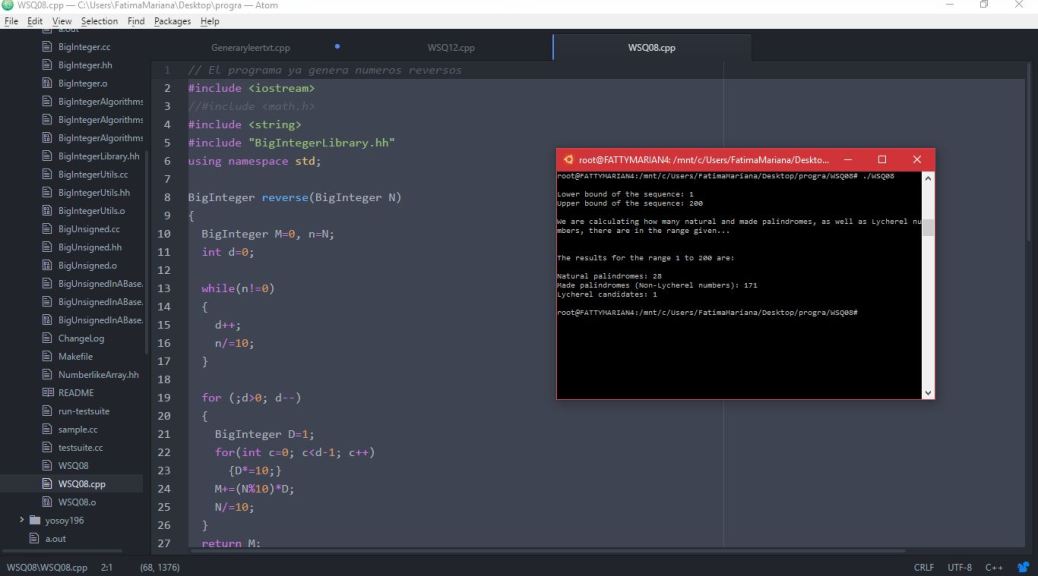The teacher gave us a document with 10 problems to solve. This with the objective of practicing the topics that we have seen during the semester.
Exercise 1:
Write a function that calculates the distance between two points in a coordinate plane. I used the Pythagoras theorem.
#include <iostream>
#include <math.h>
using namespace std;
float distancia(float x1,float y1,float x2,float y2)
{
float D;
D = sqrt(pow((x2-x1),2)+pow((y2-y1),2));
return D;
}
int main()
{
float x1, x2, y1, y2;
cout << "X1= ";
cin >> x1;
cout << "Y1= ";
cin >> y1;
cout << "X2= ";
cin >> x2;
cout << "Y2= ";
cin >> y2;
cout << distancia(x1,y1,x2,y2) << endl;
return 0;
}
Exercise 2:
A program that prints a triangle with a given size. I utilized nested for’s to print each character line by line.
#include <iostream>
#include <stdio.h>
using namespace std;
void triangle(int S)
{
for (int c=1 ; c<=S ; c++)
{
for(int i=c ; i>0; i--)
{
printf("T");
}
printf("\n");
}
for (int c=S-1 ; c>0 ; c--)
{
for(int i=c ; i>0 ; i--)
{
printf("T");
}
printf("\n");
}
}
int main()
{
int S;
cout << "\n\nSize: ";
cin >> S;
cout << "\n\n\n\n";
triangle(S);
cout << "\n\n\n\n";
return 0;
}
Exercise 3:
A program that calculates factorial numbers. I used unsigned long int as the type of the result because the factorial operation only gives integer and positive numbers. I used conditionals to mark errors and a for to multiply numbers, and then substract an unit.
#include <iostream>
using namespace std;
unsigned long int factorial(int N)
{
unsigned long int F=1;
if (N<0)
cout << "Math error!" << endl;
else if (N==0)
F=1;
else
{
for (int c=N; c>0; c--)
F*=c;
}
return F;
}
int main()
{
int N;
cin >> N;
cout << N <<"! = " << factorial(N) << endl;
return 0;
}
Exercise 4:
A function that receives a list of numbers and calculates their average. I ask for the quantity of number that will be introduced, to declare the vector. Then I read each one and introduce the vecor in a function called promedio_lista. Then I just sum the numbers with a for and divide them by the quantity of them.
#include <iostream>
using namespace std;
float promedio_lista(float calf[], int N)
{
float P=0;
for (int c=0; c<N; c++)
P+=calf[c];
P/=N;
return P;
}
int main()
{
int N;
cout << "\n\n\n¿Cuantas calificaciones vas a introducir? ";
cin >> N;
float calf[N];
cout << "\n\n";
for (int c=0; c<N; c++)
{
cout << "Calificación " << c+1 << ": ";
cin >> calf[c];
}
cout << "\nPromedio= " << promedio_lista(calf, N) << "\n\n";
return 0;
}
Exercise 5:
A function that detect the smallest number in a list of four numbers. To make this, I established that one of them were the smallest and then make comparisons with conditionals.
#include <iostream>
using namespace std;
float smallest_of_four(float a, float b, float c, float d)
{
float m=a;
if (b<m)
m=b;
else if (c<m)
m=c;
else if (d<m)
m=d;
return m;
}
int main()
{
float a, b, c, d;
cin >> a;
cin >> b;
cin >> c;
cin >> d;
cout << endl << smallest_of_four(a,b,c,d)<< endl;
return 0;
}
Exercise 6:
A function that returns a value belonging to a given position of the Fibonacci serie. The challenge is to calculate the values, but I only needed a vector whose size is equal to the position that were given. Then I asigned the first two values, which are 0 and 1 respectively, and with a for, I added the two past numbers related with the number now being calculated, until the counter is equal to the requested position.
#include <iostream>
using namespace std;
unsigned long int fibonacci(int n)
{
unsigned long int F[n];
F[0]=0;
F[1]=1;
for (int c=2; c<=n; c++)
{
F[c]=F[c-1]+F[c-2];
}
return F[n];
}
int main()
{
int n;
cin >> n;
cout << fibonacci(n) << endl;
return 0;
}
Exercise 7:
A function that receives a list of numbers and returns the sum of their squares. I used a for and the function pow of the library <math.h>
#include <iostream>
#include <math.h>
using namespace std;
double sumsquares_list(double list[], int N)
{
double Sum=0;
for (int c=0; c<N; c++)
Sum+=pow(list[c],2);
return Sum;
}
int main()
{
int N;
cout << "Cantidad de valores: ";
cin >> N;
double list[N];
for (int c=0; c<N; c++)
{
cout << "Valor " << c+1 <<": ";
cin >> list[c];
}
cout << "\n\nLa suma de los cuadrados de esos números es igual a " << sumsquares_list(list,N) << endl;
return 0;
}
Exercise 8:
A program that calculates the square root through the Babylonian Method.
#include <iostream>
using namespace std;
long double square_root(long double N)
{
long double y=1, c;
for(int i=0; i<1000; i++)
{
c=N/y;
y=(y+c)/2;
}
return y;
}
int main()
{
int N;
cout << "Square Root... \n\nNumber: ";
cin >> N;
cout << "The square root of "<< N << " is equal to "<<square_root(N) << endl << endl;
return 0;
}
Exercise 9:
A function that find the number of times that the word “banana” appears in a text file.
#include <iostream>
#include <ctype.h>
using namespace std;
#include <fstream>
bool compare(char vector_prueba[], int N=6)
{
char BANANA[6]={'b','a','n','a','n','a'};
bool result=true;
int c=0;
while(c<6)
{
if (BANANA[c]==vector_prueba[c]) c++;
else return false;
}
return true;
}
int find_Bananas(string nombre)
{
fstream ficheroEntrada;
int Ban=0;
char letra;
ficheroEntrada.open ( nombre.c_str() , ios::in);
if (ficheroEntrada.is_open()) {
while (! ficheroEntrada.eof() ) {
ficheroEntrada >> letra;
letra = tolower(letra);
if (letra == 'b')
{
char bananatest[6]={'b'};
for(int i=1; i<6; i++)
{
ficheroEntrada >> letra;
bananatest[i] = letra;
bananatest[i] = tolower(bananatest[i]);
}
if (! ficheroEntrada.eof() ){
if (compare(bananatest,6)) Ban++;
}
}
}
ficheroEntrada.close();
}
else cout << "Fichero inexistente o faltan permisos para abrirlo" << endl;
return Ban;
}
int main()
{
string nombre;
cout << "\n\nDime el nombre del fichero: ";
getline(cin,nombre);
cout << "\nThere is/are " << find_Bananas(nombre) << " banana's in the file.\n\n" << endl;
return 0;
}
Exercise 10:
A function that receives two positive integers and returns the greatest
common divisor of them. I determined which of the two values is the biggest and then I substract unit per unit until I find a value that can divide both numbers and give as a result integers. I made this with some conditionals and a while loop.
#include <iostream>
using namespace std;
int gcd(int X, int Y)
{
int D;
if(X>=Y)
D=X;
else
D=Y;
while ((X%D)!=0 || (Y%D)!=0)
{D--;}
return D;
}
int main()
{
int X,Y;
cin >> X;
cin >> Y;
cout << gcd(X,Y) << endl;
return 0;
}





